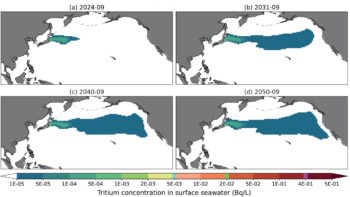
James Robson grows grapes in the Orange region of New South Wales, Australia. Ten years ago almost all his grapes went into wine for Australians; today 80% of his wine ends up in China. Australia exports beef, dairy products, fruit, honey and chocolate to China too; the nation is Australia’s number one export market. But this boost to the Australian economy has not been good news for Australia’s river systems.
Around 4% of global river water used to produce food flows from Australia to China, according to a recent study. Similarly, rivers in Pakistan, South Africa and Spain are seeing increasing demand from irrigation. Around 60% of irrigation water comes from rivers and lakes.
Irene Soligno from the Politecnico di Torino in Italy and colleagues estimated the irrigation water used to produce 270 food and agricultural goods from 1986 to 2013. Then they estimated the environmental impact of this water withdrawal on different regions of the world.
Over this 28-year period, globalisation of the food trade doubled the impact on foreign rivers, the results showed. In some countries the changes have been dramatic.
“It was remarkable to see China change from being a net exporter to a major net importer of riverine resources over this period,” says Soligno, whose findings are published in Environmental Research Letters (ERL).
Today around 25% of the food produced for human consumption is traded internationally, compared to 15% in 1986. Yet there is little information about exactly where its virtually traded water comes from, and where it ends up.
Food production is the single biggest drain on Earth’s freshwater. A rising human population, combined with climate change and improving living standards, means that agriculture’s thirst is likely to increase in future years.
Hotspots of food-related river degradation were identified in Australia, Pakistan, South Africa and Spain. Often there was a significant imbalance in the environmental effects between major exporters and importers of river water. For example, food exports from Australia, India, Thailand and South Africa result in huge environmental impact to river systems in these countries, but food consumption in these countries has little impact on foreign river systems. Meanwhile, some countries, including China and Germany, are major importers of riverine resources.
For countries with wetter climates, such as Canada, the UK and much of northern Europe, exporting food has no detrimental impact on rivers, and has even helped to reduce environmental degradation of rivers in the export countries.
International trade has reduced the pressure on rivers globally by 11%, compared to if all food was grown locally, the researchers found.
“The fact that some countries can import food goods from countries that have less vulnerable river systems has a positive effect on efficiency,” says Soligno.
International trade is currently driven by socio-economic drivers, but understanding the impact that trade has on rivers could help to reduce the pressure on these environments further.
“We highlight hotspots of food-related river-environment degradation to target priority agricultural patterns that put surface water systems at risk,” says Soligno. “In order to support policy-makers, these initial results need to be further supported by local surveys, which should consider more case-specific data and incorporate additional socio-economic, cultural and environmental aspects.”



